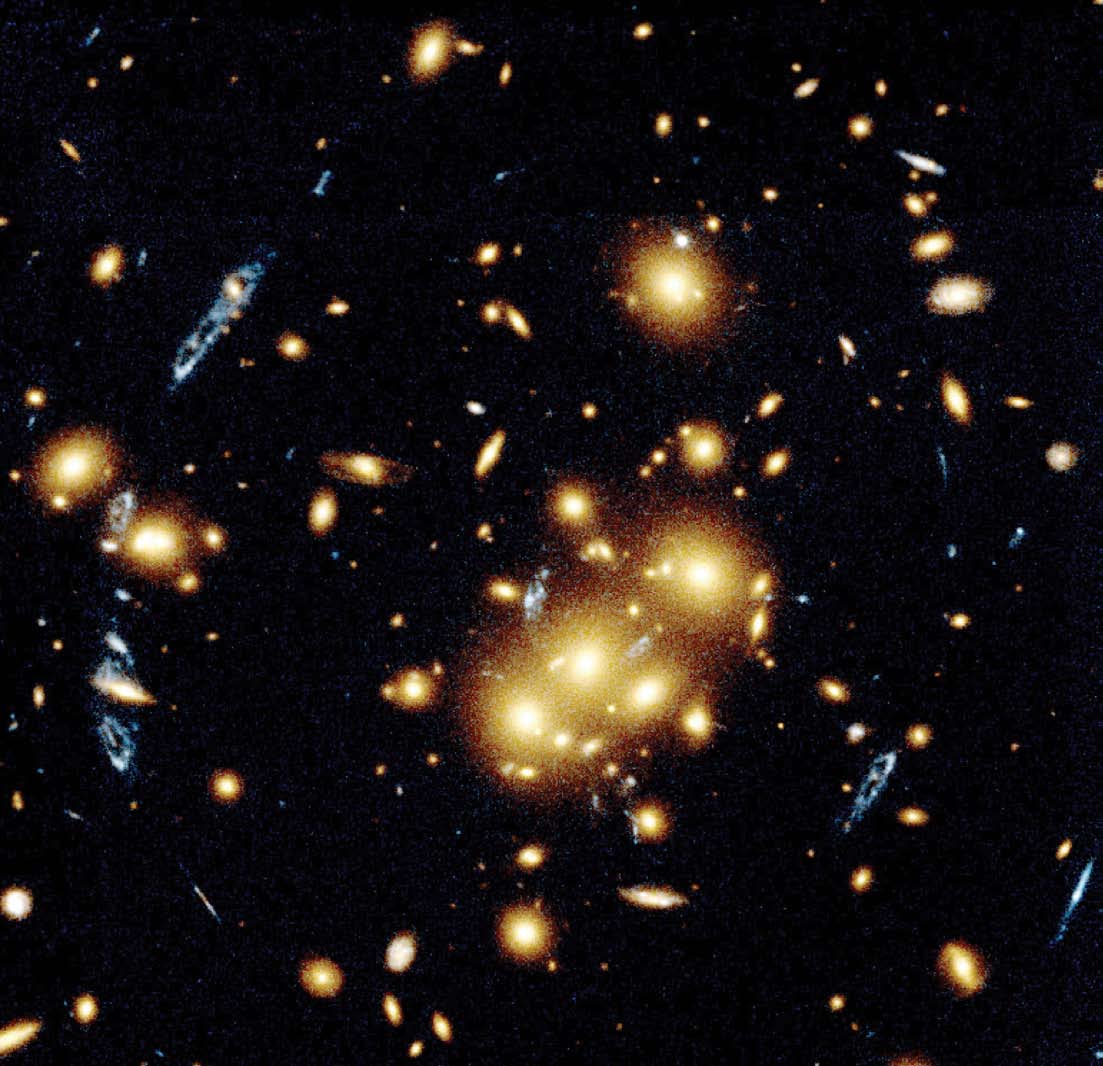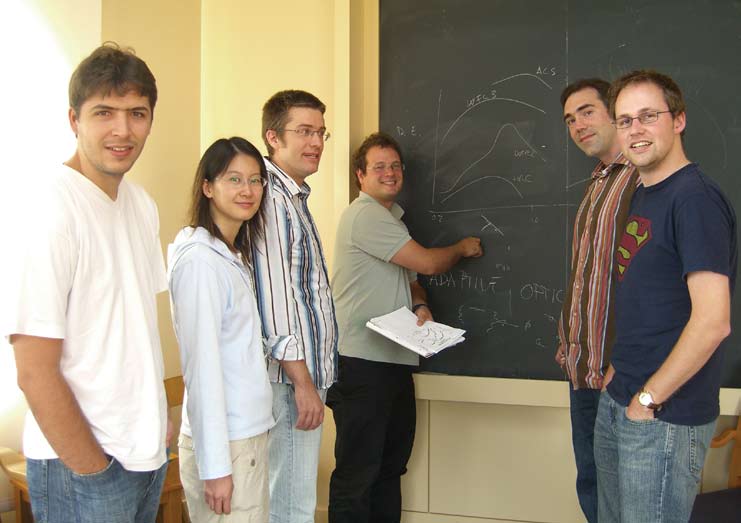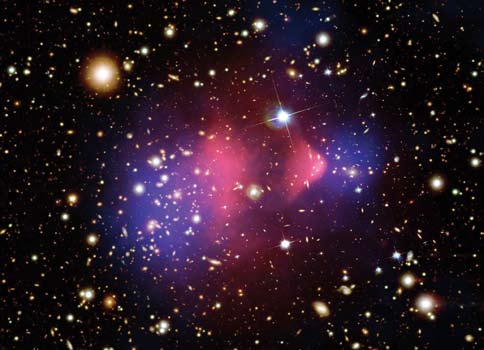 The central yellow spheres are galaxies in a cluster whose mass is a million billion times that of our Sun. The blue smears arrayed circularly around the periphery—an Einstein ring—are multiple images of a background object whose light path has been affected by the cluster. That effect requires much more mass—in dark matter—than can be accounted for by the radiant matter. NASA, W. Colley (Princeton University).
The central yellow spheres are galaxies in a cluster whose mass is a million billion times that of our Sun. The blue smears arrayed circularly around the periphery—an Einstein ring—are multiple images of a background object whose light path has been affected by the cluster. That effect requires much more mass—in dark matter—than can be accounted for by the radiant matter. NASA, W. Colley (Princeton University).
English speaking astrophysicists call the phenomenon “gravitational lensing”; the French call it “mirage gravitationnel.” The plainer English nomenclature focuses on cause; the more suggestive French, on effect.
The phenomenon itself is a vivid example of Einstein’s Theory of General Relativity in action. A massive object, such as a galaxy, between an observer on planet Earth and a distant light source acts like a “lens” parceling and bending the light from the distant source such that the Earth observer sees two or more or even a ring of images of the same distant source. The multiplicity of the images is the “mirage.”
The gravity of the massive intervening object curves Spacetime so that the shortest distance is a curved route in the apparent flat, Euclidean space for the observer (in reality a straight line in curved Spacetime). Because the light from the distant source is parceled by and around the intervening “lens,” the multiple images of the same distant object arrive at different times on earth — even as much as a year or two apart.
That time discrepancy in the arrival of images provides a key for understanding the structure of the universe.
That relationship between technique and structure was the subject of a KITP program “Applications of Gravitational Lensing: Unique Insights into Galaxy Formation and Evolution,” from Sept. 18 to Nov. 2, 2006, and conference the week of Oct. 3. The program attracted 50 participants; the conference, 120.
When gravitational lensing was first discovered in the late 1970s, astronomers hailed the phenomenon as a “natural telescope,” with emphasis on the enabling observation of the distant light source. In time it became apparent that the routes of the multiple images also mapped out the gravitational fields of the intervening objects, and those fields were a powerful indicator of the presence and the extent of “dark matter” because the visible matter could not begin to account for the gravitational fields.
Dark matter makes up 25 percent of the stuff in the universe though what it is remains unknown. The visible or “baryonic” matter — which radiates and which we can therefore see as stars and galaxies and all the stuff we know about on planet Earth — accounts for about four to five percent of the mass in the universe. The rest is something called “dark energy,” discovered inadvertently in recent surveys of distant supernovae (the subject of another KITP program and articles in this newsletter) and supported by observations of large-scale structure and the microwave background.
“Dark energy” may or may not be synonymous with the cosmological constant, a term designated by “l” (the Greek letter lambda), which Einstein introduced into his equations for General Relativity in order to counteract the force of gravity and therefore to maintain a static universe, and which he abandoned when the universe was shown to be not static, but expanding. Physicists have, if anything, less understanding of dark energy than of dark matter.
So 95 to 96 percent of what makes up the universe is a mystery.
Though physicists don’t know what the dark stuffs are, they do know how much of each there is, and the consensus that has emerged about the percentages of the three primary constituents is called “precision cosmology.”
“For 50 years,” said program/conference organizer and UCSB physicist Tommaso Treu, “the name of the game has been measuring those parameters. Now that we know how much, we want to know what that means.”
“We have a model that seems to work, but that looks very crazy,” said organizer Leon Koopmans of Kapteyn Astronomical Institute, Groningen University in the Netherlands.
That model is called “lambda CDM”: “lambda” represents the dark energy, which may or may not be the same as the cosmological constant; and “CDM” stands for “Cold Dark Matter.”
Since five to six times as much of the universe appears to be made up of dark matter, in comparison to the visible gas, stars, and galaxies, the theoretical astrophysicists who model the universe via computer simulations focus on dark matter basically to the exclusion of visible matter. (Currently, simulations of the formation and evolution of structure in the universe work with a base unit of 108 solar masses.)
“Dark matter is the backbone of galaxy formation,” asserted Treu. “Galaxies form into dark matter haloes, so if you do not understand dark matter, you cannot understand galaxy formation.”
And since dark matter doesn’t shine, it can only be “observed” gravitationally through lensing or dynamics (motion).
The idea behind the program was to bring the simulators of galaxy formation and evolution together with the experts on gravitational lensing.
What Koopmans and Treu did in organizing the program/conference was, in some sense, to scale up to the community level their personal and collaborative experiences. Said Koopmans, “I started in lensing and moved to galaxy formation, and Tommaso moved in the opposite direction. He started in galaxy formation — studying these galaxies from their light point of view, not only from their mass point of view. Our experiences gave us the idea of bringing together these communities that historically have been quite distinct.”
Interactions between the simulators and the lensers focused particularly on two issues: the dark matter sub-structure and the isothermal relationship between dark and visible matter on scales of galaxies, and also the larger clusters of galaxies.
One of the principal issues with the lambda CDM model for galaxy formation and evolution is that it works so well for simulating large-scale structure, but appears problematic for smaller scales.
“Gravitational lenses also operate on the scale of clusters of galaxies,” explained Koopmans. “Hundreds of galaxies come together into one big structure that is very massive and that itself acts as a lens for background objects, which are seen as very spectacular long arcs, for example.”
“We see these arc features,” said Treu, “a lensed object in the background that is stretched by the whole cluster. Those features indicate that there is much more mass in the cluster than you can see. We then infer how much dark matter there is and how it’s distributed. And it is distributed differently than the luminous matter. Dark matter spreads out more in a halo-like structure.”
Whence dark satellites?
 Center are program organizers Leon Koopmans (l) and Tommaso Treu with program participants, at left, Raphael Gavazzi, UCSB physics postdoc, and Sherry Suyu, KITP Fellow and Caltech graduate student, and, at right, Adam Bolton (l), Harvard-Smithsonian Center for Astrophysics fellow, and Phil Marshall, UCSB physics postdoc and Tabasgo Fellow. Photo by Charmien Carrier.
Center are program organizers Leon Koopmans (l) and Tommaso Treu with program participants, at left, Raphael Gavazzi, UCSB physics postdoc, and Sherry Suyu, KITP Fellow and Caltech graduate student, and, at right, Adam Bolton (l), Harvard-Smithsonian Center for Astrophysics fellow, and Phil Marshall, UCSB physics postdoc and Tabasgo Fellow. Photo by Charmien Carrier.
“One of the most exciting issues is whether there is some sub-structure in the dark matter too. It is predicted,” said Treu, “but still needs to be found, and lensing is one way of doing this.”
“Pure dark matter simulations yield,” said Koopmans, “many dark matter clumps, not just in clusters of galaxies, but also in galaxies. We don’t see these sub-structures in the light, so the question arises: Do these dark matter clumps not have the stars or gas in them, which would make them visible to us? Or do these dark matter clumps not exist? And if they don’t, that’s a problem for our CDM model because those substructures are its strong prediction.”
“Our Milky Way,” said Treu, “is part of what we call the local group, which includes Andromeda and the Magellanic Clouds. If you count how many satellites there are to the local group, there are very few. We don’t see them, or haven’t yet. So at the end of the '90s, a huge crisis emerged: How come galaxies like the local group don’t exhibit satellites in the halo as predicted? The simulations predict 10 to 100 times more. An amount 100 times more is not something you can shuffle away."
“Here is where lensing comes in. These things should be there; if we get our act together and find a way to observe them, we’ll find them. And that’s what we tried to do here at the KITP by bringing the communities together — collaborating on approaches to the problem that can be implemented by individual researchers afterwards."
“Then,” said Treu, “there is another side to this story; the universe is made of these strange galaxies. There is a simple sea of dark matter and dark energy, and a whole zoo-full of different galaxies. But the galaxies come in only a small range of sizes. They have some scaling relationship, so that if they have a certain mass, they can only have a certain size. Why is that the case?”
Said Koopmans, “If you look at these galaxies, certain relations among the observables emerge, such as how bright they are, how big they are, how massive. These relations are extremely tight, and you see them in these very massive elliptical galaxies and in spiral galaxies. And these relations are very strongly affected by how the dark matter would be distributed around the galaxies. So this tells us that, somehow, what we observe is following a very tight relation that is dependent on how the dark matter is distributed. So there is a very close coupling between what the dark matter is doing and what the gas and stars are doing."
“The simulations are getting better as our computers get better,” said Koopmans, “but it is extremely hard in this whole picture of the cold dark matter and hierarchical formation to find extremely tight relations — you find them approximately, but you never find them as tight as we are observing them.”
Bulge-halo conspiracy
 The “bullet” cluster — a composite x-ray lensing image depicts collision of two merging sub-clusters, whereby the weakly interacting dark matter (blue) keeps on going, while the atoms (red) interact strongly. This shows that normal matter cannot account for all the gravity of the cluster, but dark matter is needed. Image credits: X-ray: NASA/CXC/CfA/M.Markevitch et al.; Optical: NASA/STScI; Magellan/U.Arizona/D.Clowe et al.; Lensing Map: NASA/STScI; ESO WFI; Magellan/U.Arizona/D.Clowe et al.
The “bullet” cluster — a composite x-ray lensing image depicts collision of two merging sub-clusters, whereby the weakly interacting dark matter (blue) keeps on going, while the atoms (red) interact strongly. This shows that normal matter cannot account for all the gravity of the cluster, but dark matter is needed. Image credits: X-ray: NASA/CXC/CfA/M.Markevitch et al.; Optical: NASA/STScI; Magellan/U.Arizona/D.Clowe et al.; Lensing Map: NASA/STScI; ESO WFI; Magellan/U.Arizona/D.Clowe et al.
“After sub-structure,” said Treu, “the second most exciting part of this program is what Leon and I like to call the ‘bulge-halo conspiracy.’ Imagine you have a galaxy, and you can measure by a miracle (in this case gravitational lensing with something else) the run of the density of mass with respect to radius. The galaxy is dense in the center and becomes less and less dense outwards. With lensing you can measure the total mass density profile because you don’t care if it’s stars or dark matter. The surprising thing is that no matter what you do, it looks like the dark matter and the luminous matter conspire to form what we call an ‘isothermal mass profile.’”
“In other words,” clarified Koopmans, “if you add up the stars and gas and dark matter, the density profile is the same for these elliptical galaxies as for spiral galaxies. You don’t see much of a difference. If you look at the more massive galaxies, you see lots of differences between how their light is distributed, but somehow the dark matter compensates in such a way that the density profile stays the same.”
Said Treu, “The law is extremely simple. The density is proportional to one over the radius squared.”
The dark matter complements the baryonic matter so that the same relationship pertains?
“Yes,” said Treu, “the sum of the two miraculously always ends up looking like this, so the two affect each other. There is some kind of fundamental structure, and the two adjust to each other somehow. Sometimes that relationship is called the ‘attractor,’” said Treu.
“This is an unexplained phenomenon,” said Koopmans.
“What happened here in this program,” said Treu, “is that we grappled with two big ideas — the substructure and the isothermal relationship. Communities, who don’t traditionally talk much to each other, did. It was a big success.”
“Indeed,” added Koopmans, “I think how successful was reflected by the large turnout at the conference — 120 participants!”
In addition to Koopmans and Treu, the other organizers of the program included Chung-Pei Ma of Berkeley, Ben Moore of the University of Zurich, and Peter Schneider of the Argelander-Institut für Astronomie in Bonn.
 Simulation of the growth of structure with arrow of time going from left to right.
Simulation of the growth of structure with arrow of time going from left to right.
